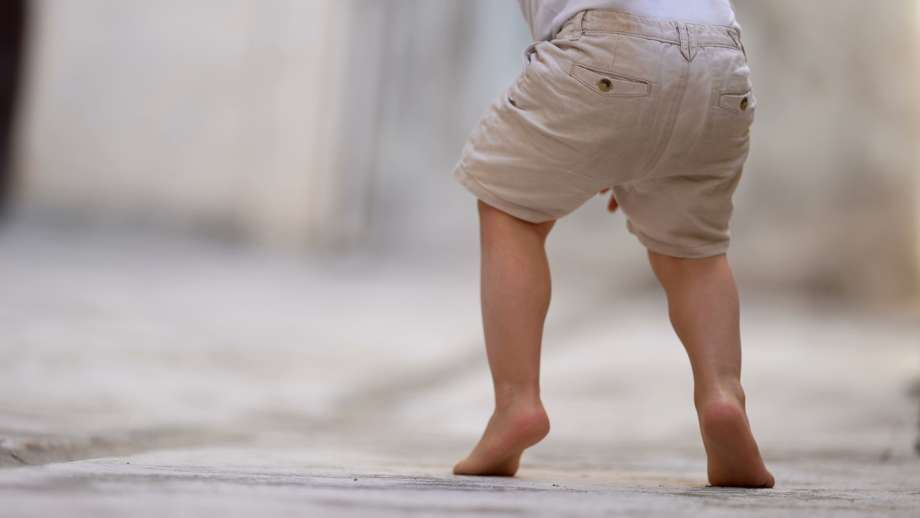My Child Is Toe Walking: Is There a Bigger Problem?

Walking on tiptoes is a common habit for young children, but is it something that parents should worry about? Is toe walking in children something that they’ll grow out of, or is it a sign of an underlying condition?
If your child is a toe walker, you might be concerned that this indicates a larger issue or medical condition. While toe walking can be an early sign of some underlying conditions, typically it’s something that children will stop doing overtime. To learn more about toe walking in children and when you should talk to your child’s doctor, read on below.
What is Toe Walking?

Toe walking refers to when a child persistently steps on the balls of their feet, making it appear as though they’re walking on their tiptoes. Another term for this is idiopathic toe walking, or persistent toe walking without any clear reason behind it.
What Causes Toe Walking in Children?
Why do some children walk on their tiptoes? There are a few different reasons. When a child is first learning to walk, they might try out several different walking patterns. A typical developmental progression of milestones involves children first walking on their tiptoes, then stepping with a flat foot on the ground, and then finally walking in a heel-toe pattern.
Most children will progress through these milestones in the first few years of life, with most kids walking in a standard heel-toe pattern by about age 3, but developmental delays and variations in walking patterns are possible. Some children might continue to toe walk occasionally, but most chronic toe walkers will stop walking on their tiptoes on their own by 5 years of age.
Underlying Conditions in Toe Walkers
As a parent, you might wonder if you should worry about your child walking on their tiptoes. Generally, toe walking on its own does not indicate a serious problem, but if you are concerned, talking to your child’s pediatrician is always a good first step.
What are some of the underlying conditions that toe walking might be a sign of? Sometimes it’s because your child has tight calf muscles or a short Achilles tendon. If this is the case, your child’s doctor might refer you to a pediatric physical therapist for additional assessment and potential treatment.
Toe walking can sometimes be a sign of conditions that impact motor skills, like autism spectrum disorder, cerebral palsy, ADHD, and muscular dystrophy. It’s important to note that toe walking on its own does not mean that your child has one of these conditions. A pediatrician will be better able to assess your child’s development, family history, and other explanations for your child’s walking pattern.
My Child is a Toe Walker: What Should I Do?

When does it make sense to talk to a doctor about your child’s toe walking? In general, it’s best to consult your child’s pediatrician if your child is toe walking and also:
- Has a family history of autism, ADHD, or muscular dystrophy
- Shows other developmental delays, like poor motor skills or avoiding eye contact
- Is uncoordinated or has stiff muscles
- Had a premature birth or birth complications
- Previously walked with a flat foot or heel-toe pattern and has only now begun toe walking
- Persistently toe walks most of the time past the age of 3
As with any other concerns you might have about your child, it never hurts to mention your concerns to your child’s doctor at their regular check-up. If nothing else, it should help you to have more peace of mind about your child’s toe walking.
Treatment Options for Toe Walkers

There are a few different methods that doctors and physical therapists can use to treat toe walking in children. Usually, treatment will depend on the underlying condition or reason for the child’s toe walking.
If a child toe walks because they have tight calf muscles or a short Achilles tendon, the first step will likely be physical therapy or stretching to help improve your child’s range of motion. Gentle stretches in physical therapy sessions and at home can help relieve muscle tightness and tension if that’s the root cause of a child’s toe walking. Other options for treatment include serial casting or wearing leg braces or splints. Typically, these treatment methods are sufficient to help promote a normal gait and walking pattern.
Rarely, surgery might be recommended to help lengthen the muscles and tendons at the back of the leg. Another rare treatment option involves administering botox injections to the calf muscles to release tension. These are typically only pursued as a treatment option if the other treatments listed above have been unsuccessful.
If your child’s toe walking is a result of another underlying condition like autism or cerebral palsy, your child’s doctor will likely focus on treating that underlying condition rather than the toe walking itself.
Generally, toe walking isn’t something that most parents should be concerned about, especially if your child is meeting their other developmental milestones.
For more helpful info on toddler growth and development, see Baby & Toddler Health & Safety.


